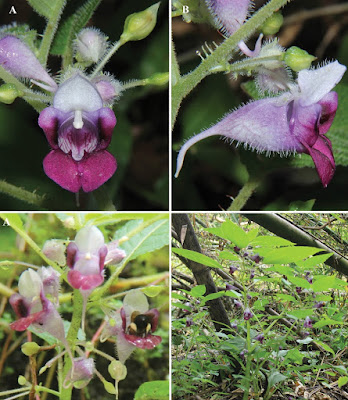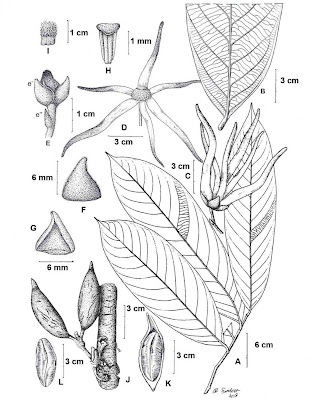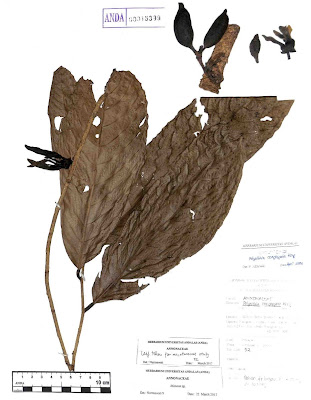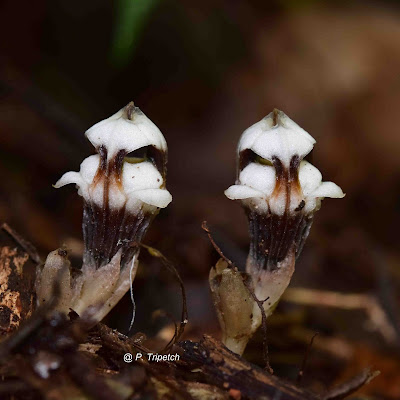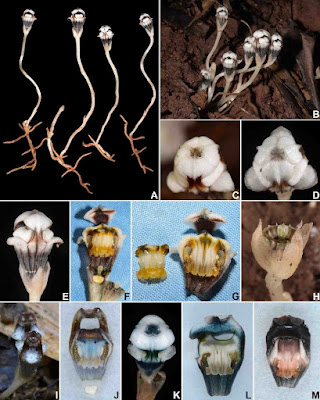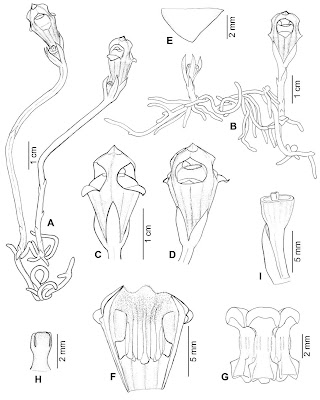[Most Recent Entries] [Calendar View]
Monday, June 24th, 2019
| Time | Event | ||||||
| 1:55a | [Botany • 2019] Impatiens jenjittikuliae (Balsaminaceae) • A New Species from Northern Thailand
Abstract Impatiens jenjittikuliae Ruchis. & Suksathan, a new species from a limestone area in Thasongyang District, Tak Province, Northern Thailand, is described and illustrated. This endemic new species is distinguished from the most similar, I. lacei Hook.f. through having pilose lateral sepals vs glabrous, and by the absence of long hairs along the lamina margin. Its pollen and seed morphology, stem anatomy, and pollination ecology are also observed. Furthermore, its conservation status as Critically Endangered is also assessed. Keywords: Uniflorae, lithophytic, endemic, critically endangered
Impatiens jenjittikuliae Ruchis. & Suksathan, sp. nov. Diagnosis: Impatiens jenjittikuliae is most similar to I. lacei Hook.f. It differs from I. lacei by its densely pilose lateral sepal (versus glabrous) and by having no long hairs along its lamina margin (versus distinct long hairs especially along the lower-half of leaf margin). ... Distribution: The new species is only known from the type locality in Tak Province, Thailand. Ecology: Impatiens jenjittikuliae grows on limestone close to waterfall in a mixed deciduous forest, 520–600 m elevation (pers. obs.). Etymology: The new species is named in honor of Dr. Thaya Jenjittikul who encouraged the first author to step in and study this lovely plant family. Pollination ecology: The author observed five visitations by bees from the family Apidae (identified by an entomologist, Pornpimon Tangtorwongsakul) during the expeditions. The size of bee body fit well with the floral entrance (Fig. 6). Moreover, the floral structure of this new species is similar to other bee-pollinated species, e.g. I. psittacina (Ruchisansakun et al. 2016). Hence, we concluded that it is a bee-pollinated species.
Discussion: Impatiens jenjittikuliae is similar to I. lacei and the other species closely related to I. pulchra Hook.f (= I. mengtszeana Hook.f. in Ruchisansakun et al. 2015) in its raceme inflorescence, shape of flower, and short fusiform capsule. The short fusiform capsule and the 4-colpate pollen grains of the new species support its placement in the subgenus Impatiens (Yu et al. 2015). In addition, I. jenjittikuliae has seeds coated with inflated cells with granulate walls similar to those described in species, such as I. napoensis Y. L. Chen, within the sect. Uniflorae (Janssens et al. 2012; Yu et al. 2015). The cross sections of the stem of I. jenjittikuliae have shown that the new species is herbaceous, similar to the morphologically similar species in the sect. Uniflorae, I. pulchra, which also show in Lens et al. (2012) as I. mengtszeana Hook.f. (Lens et al. 2012; Ruchisansakun et al. 2015; Yu et al. 2015). Saroj Ruchisansakun and Piyakaset Suksathan. 2019. Impatiens jenjittikuliae (Balsaminaceae), A New Species from Thailand. PhytoKeys. 124: 139-147. DOI: 10.3897/phytokeys.124.33607 | ||||||
| 2:05a | [Botany • 2019] Thismia domei & T. terengganuensis (Thismiaceae) • Two New Species, and T. javanica, A New Record from Terengganu, Peninsular Malaysia
Abstract Two new species of the mycoheterotrophic genus Thismia Griff. (Thismiaceae), Thismia domei Siti-Munirah and T. terengganuensis Siti-Munirah from Peninsular Malaysia, are described and illustrated. Thismia domei, characterized by its perianth lobes that are upright and curve inward, but are imperfectly connate, falls within section Odoardoa. Thismia terengganuensis is characterized by its mitre with three appendages on its apex, so falls within section Geomitra. Both new species are unique and totally different from other described species, T. domei by the trichomes on its outer perianth tube surface and T. terengganuensis by its mitre with slender appendages. Thismia javanica J.J.Sm, also from Terengganu, is a new record for Peninsular Malaysia. Keywords: Thismia, taxonomy, mycoheterotrophy, new species, Telemong Forest Reserve, Terengganu, Peninsular Malaysia Thismia domei M.Y.Siti-Munirah, sp. nov. Diagnosis: The whole plant is completely white translucent and the flower is strigose with white trichomes covering the outer surface of the perianth tube and ovary; the apex of the perianth tube is partially covered by the apical part of flower tube with a ring-like annulus and together with six perianth lobes are upright and curve inwards with a dorsal long appendage on each lobe. .... Distribution: Endemic in Peninsular Malaysia, Terengganu. Currently known only from the type collection. Ecology: In lowland dipterocarp forest on wet, moist soil in shade at an altitude of 207 m. Flowering in November-December. This new species was encountered on bamboo leaf litter near an elephant trail. When mature T. domei produces an unpleasant smell like rotting fish. Etymology: The species is named after Mr Dome Nikong, professional photographer and freelance researcher, who first discovered this species and the other new species described below as well as T. javanica. Notes: Thismia domei, based on colour, is most like T. clavarioides K.Thiele (Thiele and Jordan 2002) and Thismia taiwanensis S.-Z. Yang, R. M. K. Saunders & C.-J. Hsu, (Yang et al. 2002). Both have completely white perianth lobes that are upright and curved inwards towards the perianth tube with an appendage on each lobe. However, T. domei differs from these species in that its perianth tube is fully covered with thick trichomes and it has six perianth lobes each with an appendage as opposed to being completely glabrous and T. taiwanensis from Taiwan has only three perianth lobes with appendages and the perianth of T. clavarioides forms a mitre from Australia. T. domei is unusual in its conspicuous cell inclusion white spot which appear to be aleurone grains. Thismia terengganuensis M.Y.Siti-Munirah, sp. nov. Diagnosis: Thismia terengganuensis is unique in its perfect mitre with the long filiform appendages not seen in any other species of Thismia. It has a racemose sessile inflorescence with large bracts. Its flower parts are brownish with brown striae with inner perianth lobes forming a dark brown mitre with a white slender appendage attached at apex. The outer perianth lobes at interval appear like a wing. It has creeping vermiform brown roots. ... Distribution: Endemic in Peninsular Malaysia, Terengganu. Currently only known from the type locality. Ecology: In lowland dipterocarp forest on wet, moist soil in shade at altitude 227 m. Flowering in November-December on forest floor under canopy of dense shrubs. Etymology: The epithet refers to the state, Terengganu, where it was found.
Notes: Thismia terengganuensis is most similar to species in sect. Sarcosiphon and sect. Geomitra in the shape of the perianth tube and mitre but differs in all other morphological parts, e.g. in its slender filiform appendages on the apex of mitre and also its connectives that are blunt without any apical appendages. New record: Thismia javanica J.J. Sm., Ann. Jard. Bot. Btzg. 23: 32. 1910 Jonker, Fl. Malesiana 1,4: 23. 1948; Larsen, Fl. Thailand 5,1: 125. 1987. Specimen: Dome Nikong FRI 91114 (KEP!)
Distribution: Indonesia, Malaysia and Thailand. Notes: The specimens of Thismia javanica were found not far from the T. terengganuensis population. We believe that T. javanica has a wider distribution in Peninsular Malaysia based on photographs of a specimen from Langkawi, Kedah, by late Abd Ghani Hussain. Unfortunately, there are no specimen to verify this. Mat Yunoh Siti Munirah and Dome Nikong. 2019. Thismia domei and T. terengganuensis (Thismiaceae), Two New Species, and T. javanica, A New Record from Terengganu, Peninsular Malaysia. PhytoKeys. 124: 123-137. DOI: 10.3897/phytokeys.124.34728 | ||||||
| 3:08a | [Entomology • 2019] Paraxiphidium iriodes • The Little Harlequin Katydid — A New Species of Paraxiphidium Redtenbacher, 1891 (Orthoptera: Tettigoniidae: Conocephalinae) from the Amazonian Rainforest
Abstract Paraxiphidium is a genus of flashy Neotropical katydids belonging to Conocephalini. Paraxiphidium iriodes sp. nov. is described from the Brazilian Amazon region. This is the first record of the genus for Brazil. The description of stridulatory file, male internal genitalia and data on natural history is provided. A key is included to the species of the group and a map with the geographical records completes the paper. Keywords: Orthoptera, Spine-headed katydid, Brazilian Amazon, colorful katydids, Conceveiba Paraxiphidium iriodes sp. nov. Diego Matheus De Mello Mendes and Jomara Cavalcante De Oliveira. Originator. 2019. The Little Harlequin Katydid — A New Species of Paraxiphidium Redtenbacher, 1891 (Orthoptera: Tettigoniidae: Conocephalinae; Conocephalini) from the Amazonian Rainforest. Zootaxa. 4623(1); 151–162. DOI: 10.11646/zootaxa.4623.1.10 | ||||||
| 10:01a | [Botany • 2019] Monoon longipetalum (Annonaceae) • A New Species from Sumatra, Indonesia
Abstract A new species Monoon longipetalum Nurmawati from Sumatra is described and illustrated. It is notable for its long lanceolate and narrowed petals to ca. 9 × 0.8 cm, velutinous on upper surface more densely to the apex of the inner and outer petals; large fusiform to 7 × 2 cm and bluntly apiculated monocarps. This new species is similar to Monoon anomalum (Becc.) B. Xue & R.M.K. Saunders and Monoon borneense (H. Okada) B. Xue & R.M.K Saunders for having fusiform monocarp and long bluntly apiculate, but differ in having fewer clustered flowers in each inflorescence, lanceolate, longer, and narrower petals. Detailed morphological characters together with illustrations and diagnostic comparisons are presented. A key to the 19 species of Monoon in Sumatra is provided. Keyword: Annonaceae, Monocarps fusiform, Monoon anomalum, Monoon borneense, West Sumatra
Monoon longipetalum Nurmawati, sp. nov. Diagnosis: Monoon longipetalum is morphologically similar to M. anomalum (Becc.) B. Xue & R.M.K. Saunders and M. borneense (H. Okada) B. Xue & R.M.K. Saunders, both occurring in Sumatra with fusiform monocarps, wrinkled surface when dried, and long bluntly apiculate. Although the new species shares some characters with M. anomalum and M. borneense, the three species can be easily individually identified with the combination of characters presented in table 1. ... Etymology: The specific epithet longipetalum is referring to the long petals. Distribution, habitat and ecology: Monoon longipetalum has been recorded from two locations in West Sumatra: Ngalau Pangian, Lintau Buo and Dusun Kalo-kalo, Tabek Panjang Lintau. Both are in Tanah Datar district. This region is located at elevations between 200 and 500 m above sea level. Rainfall in this subdistrict area averages 172.06 mm per year. This species grows on limestone hills or along river banks. Subekti Nurmawati, Nunik Sri Ariyanti, Tatik Chikmawati and Paul J. A. Kessler. 2019. Monoon longipetalum (Annonaceae), A New Species from Sumatra, Indonesia. Taiwania. 64(3); 235-239. DOI: 10.6165/tai.2019.64.235 | ||||||
| 4:37p | [Botany • 2019] Thismia submucronata (Thismiaceae) • A New Species from Mainland Southeast Asia
Abstract Thismia submucronata is described and illustrated as a new species from Thailand. The new species is characterized by 1) vermiform roots, 2) inner perianth lobes forming a convex mitre with a mucro together with three foveae at apex, 3) the inner surface of perianth tube possessing an irregularly reticulate surface without transverse bars, 4) the presence of papillate hairs at the annulus surface and the outer surface of stamen filaments, and 5) the stamens positioned almost at apex of annulus. Morphological description, illustrations of the new species and a comparison with the related species are presented. Keyword: Mycoheterotrophy, New species, Thailand, Thismia submucronata, Thismiaceae Thismia submucronata Chantanaorr., Tetsana & Tripetch, sp. nov. Diagnosis: Thismia submucronata is similar to T. mucronata, but differs in having three foveae together with a mucro at the apex of the mitre and outer surface of stamen filaments and both surfaces of annulus covered by papillate hairs. ... Etymology: The specific epithet “submucronata” refers to the presence of a short mucro at the top of the mitre. Habitat, ecology and distribution: Thismia submucronata is known only from two localities: Phu Hin Rong Kla [Phitsanulok province] and Phu Suan Sai National Parks [Loei province]; however, it may also occur in other areas of Northern and Northeastern Thailand with similar climatic conditions and vegetation type. The new species grows amongst leaf litter, under shade of moist evergreen forest, near waterfall or streamside, at elevation of 1200−1300 m. Flowering and fruiting was observed from May to July. Sahut Chantanaorrapint, Naiyana Tetsana, Petch Tripetch and Somran Suddee. 2019. Thismia submucronata (Thismiaceae), A New Species from Mainland Southeast Asia. Taiwania. 64(3); 240-244. DOI: 10.6165/tai.2019.64.240 |
| << Previous Day |
2019/06/24 [Calendar] |
Next Day >> |
